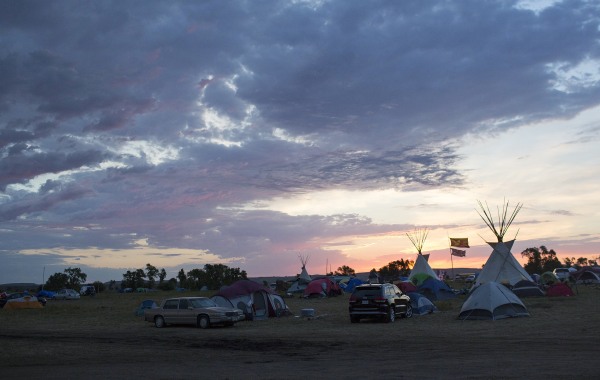Standing Rock Pipeline Fight Draws Hundreds to North Dakota Plains
Standing Rock Pipeline Fight Draws Hundreds to North Dakota Plains
(video at link)
Pipeline Fight Unites Indigenous People 4:08
The largest gathering of indigenous nations in modern American history has set up camp on land belonging to the Army Corps of Engineers at the confluence of the Cannonball and Missouri rivers in North Dakota. Tents and teepees, now home to whole families, stretch the plain. They have come by the hundreds to protest construction of the 1,172-mile Dakota Access oil pipeline, which would run within a half-mile of the Standing Rock Sioux reservation and cross beneath the Missouri River. Opponents say the pipeline will adversely impact drinking water and disturb sacred tribal sites.
Reporter Sasha von Oldershausen spent three days with the protesters to see how they are living and to learn why they have answered the call of the Standing Rock Sioux.
NEAR CANNON BALL, N.D. — Winter is coming to the plains. At all times of the day, when there is lumber to chop, men throw their weight into axes and cut firewood for the frigid days ahead. One tribe from Wisconsin recently visited the camp with a logging truck filled with lumber that 20 men unloaded by hand. The camp relies on these donations for its survival, and wood is scarce. "We need to conserve our wood," Everett Iron Eyes, a Standing Rock Lakota and camp organizer, said to people packed beneath the large, brown canopy of tent at the top of a hill. Just below, hundreds have been camping for months in protest of the Dakota Access pipeline.
"Our people survived hundreds of years in the snow," he said, the heavy canvas walls snapping like sails from the blustery wind. Inside, all was still as people sat cross-legged or stood along the fringes. Elders occupied the few available metal fold-out chairs. Everyone was listening.

A man chops wood at the Standing Rock Indian Reservation in North Dakota on Sept. 21 as demonstrators gathered to protest the construction of an oil pipeline. Jim Seida / NBC News
"You can see the birds and animals getting ready," Iron Eyes said quietly. "We have to, too."
Fire is more than just a source of warmth for the camp. At night, campfires accompany a perpetual drumbeat that fades only after the voices do. Teepees glow like paper lanterns illuminated by campfires burning within. "Water is Life" is the official motto of the pipeline opposition movement, but fire is what fuels its resolve. "I see some of you making big fires that you sit around late into the night," he said. "We can't be doing that."


 http://www.nbcnews.com/news/us-news/standing-rock-pipeline-fight-draws-hundreds-north-dakota-plains-n665956
http://www.nbcnews.com/news/us-news/standing-rock-pipeline-fight-draws-hundreds-north-dakota-plains-n665956



